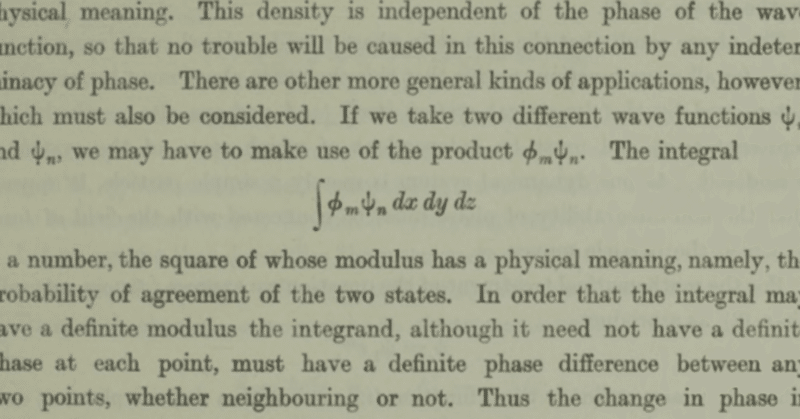
ディラックの歴史的論文(1931年:陽電子)を探して
1931年発表の "Quantised singularities in the electromagnetic field"(電磁場における量子化された特異点)です。今でいう磁気単極子(magnetic monopole)の存在可能性を論証した論文で、2023年現在も未発見ですが、宇宙創成の成り立ちを探るカギとして有力視されています。詳細はウィキペディアにあるのでここでは触れません。

The steady progress of physics requires for its theoretical formulation a mathematics that gets continually more advanced. This is only natural and to be expected. What, however, was not expected by the scientific workers of the last century was the particular form that the line of advancement of the mathematics would take, namely, it was expected that the mathematics would get more and more complicated, but would rest on a permanent basis of axioms and definitions, while actually the modern physical developments have required a mathematics that continually shifts its foundations and gets more abstract. Non-euclidean geometry and non-commutative algebra, which were at one time considered to be purely fictions of the mind and pastimes for logical thinkers, have now been found to be very necessary for the description of general facts of the physical world. It seems likely that this process of increasing abstraction will continue in the future and that advance in physics is to be associated with a continual modification and generalisation of the axioms at the base of the mathematics rather than with a logical development of any one mathematical scheme on a fixed foundation.
しょっぱなから攻めてきていますポール。以下はDeepLによる和訳。
物理学の着実な進歩は、その理論的な定式化のために、絶えず進歩する数学を必要とする。これは当然のことであり、予想されることである。 しかし、前世紀の科学者たちが予想していなかったのは、数学の進歩がどのような形をとるかということであった。すなわち、数学はますます複雑になっていくが、公理と定義という恒久的な基礎の上に成り立っていると予想されていた。 非ユークリッド幾何学や非可換代数は、一時期は論理的思考者の娯楽であり、純粋に頭の中の虚構であると考えられていたが、今では物理世界の一般的事実を記述するために非常に必要であることがわかっている。物理学の進歩は、固定された土台の上に一つの数学的スキームを論理的に発展させるのではなく、数学の基礎となる公理の絶え間ない修正と一般化に関連している。
簡潔な数式にすべてを落とし込むことを究極の美とする、彼らしい宣言ではあるのですが…
この少し後に、天敵パウリの名と、彼から批判を受けた「空孔理論」について新アイディアを語るのです。
A recent paper by the author* may possibly be regarded as a small step according to this general scheme of advance. The mathematical formalism at that time involved a serious difficulty through its prediction of negative kinetic energy values for an electron. It was proposed to get over this difficulty, making use of Pauli’s Exclusion Principle which does not allow more than one electron in any state, by saying that in the physical world almost all the negative-energy states are already occupied, so that our ordinary electrons of positive energy cannot fall into them. The question then arises as to the physical interpretation of the negative-energy states, which on this view really exist. We should expect the uniformly filled distribution of negative-energy states to be completely unobservable to us, but an unoccupied one of these states, being something exceptional, should make its presence felt as a kind of hole. It was shown that one of these holes would appear to us as a particle with a positive energy and a positive charge and it was suggested that this particle should be identified with a proton. Subsequent investigations, however, have shown that this particle necessarily has the same mass as an electronf and also that, if it collides with an electron, the two will have a chance of annihilating one another much too great to be consistent with the known stability of matter.
著者*による最近の論文は、この一般的な進歩のスキームに従えば、おそらく小さな一歩とみなされるかもしれない。 当時の数学的形式論は、電子の運動エネルギー値が負になることを予言するという深刻な難題を抱えていた。 パウリの排他原理を利用することで、この難題を克服することが提案された。パウリの排他原理は、どのような状態でも電子が1つ以上存在することを許さないというもので、物理世界では、ほとんどすべての負のエネルギー状態がすでに占有されており、正のエネルギーを持つ通常の電子はそのような状態に落ちることはできない。 そこで、この考え方によれば本当に存在する負エネルギー状態の物理的解釈が問題となる。 一様に充填された負エネルギー状態の分布は、我々にはまったく観察できないはずである。しかし、これらの状態のうち占有されていないものは、例外的なものであり、一種の穴としてその存在を感じさせるはずである。 この穴のひとつが、正のエネルギーと正の電荷を持つ粒子として現れることが示され、この粒子を陽子と同定することが提案された。 しかし、その後の調査によって、この粒子は必然的に電子fと同じ質量を持ち、また、電子と衝突した場合、2つが互いに消滅する可能性が、既知の物質の安定性と一致するにはあまりにも大きいことが示された。
そして今話題のオッペンハイマーの名も出てきます。
It thus appears that we must abandon the identification of the holes with protons and must find some other interpretation for them. Following Oppen- heimer, we can assume that in the world as we know it, all, and not merely nearly all, of the negative-energy states for electrons are occupied. A hole, if there were one, would be a new kind of particle, unknown to experimental physics, having the same mass and opposite charge to an electron. We may call such a particle an anti-electron. We should not expect to find any of them in nature, on account of their rapid rate of recombination with electrons, but if they could be produced experimentally in high vacuum they would be quite stable and amenable to observation. An encounter between two hard y-rays (of energy at least half a million volts) could lead to the creation simultaneously of an electron and anti-electron, the probability of occurrence of this process being of the same order of magnitude as that of the collision of the two y-rays on the assumption that they are spheres of the same size as classical electrons. This probability is negligible, however, with the intensities of y-rays at present available.
従って、陽子と正孔を同一視することを放棄し、正孔について何か他の解釈を見つけなければならないようだ。 オッペンハイマーに倣って、我々が知っている世界では、電子の負エネルギー状態はすべて(単にほとんどすべてではなく)占有されていると仮定することができる。 穴があるとすれば、それは実験物理学では未知の新しい種類の粒子であり、電子と同じ質量と反対の電荷を持つ。 このような粒子を反電子と呼ぶこともできる。 反電子は電子との再結合速度が速いため、自然界には存在しないと思われるが、もし高真空中で実験的に作ることができれば、極めて安定で観測に適した粒子となるだろう。 少なくとも50万ボルトのエネルギーを持つ)2つの硬いY線が出会えば、電子と反電子が同時に生成される可能性がある。この過程の発生確率は、Y線が古典的な電子と同じ大きさの球体であると仮定した場合の2つのY線の衝突の確率と同じオーダーである。 しかし、この確率は、現在利用可能なY線の強度では無視できるものである。
パウリはこの頃、盟友ハイゼンベルクといっしょに「場の量子論」を探っていて、ディラックがこの2年前より提唱していた「空孔理論」を毛嫌いしていました。実際この理論には欠陥点があって、ディラックもそこを気にしていたのです。正面から言い返さず、このテーマとは違う論文の冒頭でこの理論の修正案を出して、そこから先は違う話に進んでいく、そういう書き方をしています。
それまで彼は、この「空孔理論」のなかで陽子に関する新解釈を展開していましたが、パウリに批判されたのを受けて、陽子ならぬ「陽電子」の存在可能性を切り出したのがこの論文です。電子とペアとなる反電子つまり「陽電子」。これは翌年に宇宙線から発見されることになります。
ただ肝心の「空孔理論」を裏付けるものとはならなくて、さらに翌年にパウリからこっぴどく弱点を叩かれて、これで同理論は命脈が尽きて終わりました。
皮肉なことにこの1933年12月、ポール・ディラックはノーベル物理学賞を授けられます。世間的には栄光の極みでしたが彼にとっては挫折の年となったのでした。
この記事が気に入ったらサポートをしてみませんか?
